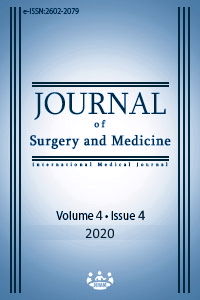Iron poisoning
Keywords:
Iron, Poisoning, ToxicAbstract
Iron, represented by Fe on the periodic table, is the fourth most common element found on Earth. Although it has important tasks in the human body such as oxygen transfer, DNA synthesis, and electron exchange, it may also become toxic and harmful in excess. The toxicity of iron poisoning starts to appear with an intake of 20 mg/kg of elementary iron ions, along with GIS symptoms. In iron poisoning, patients usually present with various clinical findings and symptoms such as nausea, vomiting, palpitation, metabolic acidosis, deteriorated respiration, or mental disorders varying up to coma. Intervention in all patients begins with ABC evaluation, obtaining vascular access, monitoring, and (if necessary) providing oxygen support. Endotracheal intubation can be considered to ensure airway security and avoid aspiration, especially for lethargic patients. After abdominal and intestinal lavage, IV support treatment can begin, considering the liquid-electrolyte deficiency of these patients. In patients with a poor general condition and toxic appearance, hemogram, serum iron levels, kidney function tests, liver function tests, serum electrolytes, coagulation panel, arterial or venous blood gas, lactate, and in women of childbearing age, β-Hcg tests should be obtained. Abdominal radiography can be planned in the early stage. In patients thought to have serious iron poisoning, chelation treatment with deferoxamine is administered without delay.
Downloads
References
Yousif LF, Stewart KM, Kelley SO. Targeting Mitochondria with Organelle-Specific Compounds: Strategies and Applications. Chem Bio Chem. 2009 Aug 17;10(12):1939–50.
Gummin DD, Mowry JB, Spyker DA, Brooks DE, Fraser MO, Banner W. 2016 Annual Report of the American Association of Poison Control Centers’ National Poison Data System (NPDS): 34th Annual Report. Clinical Toxicology. 2017 Nov 26;55(10):1072–254.
Bateman DN, Eagling V, Sandilands EA, Jackson G, Crawford C, Hawkins L, Cheung T, Cooper G, Bradberry SM, Thompson JP, Thomas SHL, Eddleston M. Iron overdose epidemiology, clinical features and iron concentration-effect relationships: the UK experience 2008–2017. Clinical Toxicology. 2018 Nov 2;56(11):1098–106.
Anderson BD, Turchen SG, Manoguerra AS, Clark RF. Retrospective analysis of ingestions of iron containing products in the united states: are there differences between chewable vitamins and adult preparations? J Emerg Med. 2000 Oct;19(3):255–8.
Liebelt EL, Burns MM, Wiley JF. Acute iron poisoning - UpToDate [Internet]. [cited 2020 Apr 9]. Available from: https://0212a86mi-y-https-www-uptodate-com.proxy.sakarya.deep-knowledge.net/contents/acute-iron-poisoning?search=Acute%20Iron%20Poisoning&source=search_result&selectedTitle=1~150&usage_type=default&display_rank=1
Yuen H-W, Becker W. Iron Toxicity. In: StatPearls [Internet]. Treasure Island (FL): StatPearls Publishing; 2020 [cited 2020 Apr 9]. Available from: http://www.ncbi.nlm.nih.gov/books/NBK459224/
Ávila RA, Silva MASC, Peixoto JV, Kassouf-Silva I, Fogaça RTH, dos Santos L. Mechanisms involved in the in vitro contractile dysfunction induced by different concentrations of ferrous iron in the rat myocardium. Toxicology in Vitro. 2016 Oct;36:38–45.
Ferrous sulfate overdose: Various toxicities: case report. Reactions Weekly. 2013 Apr;1449(1):16–16.
Ravindhran B, Karthikeyan K, Jayakumar V, Mitta N, Subramanyam S. Early Intestinal Obstruction in Iron Toxicity – An Unheard of Occurrence. JCDR [Internet]. 2018 [cited 2020 Apr 9]; Available from: http://jcdr.net/article_fulltext.asp?issn=0973-709x&year=2018&volume=12&issue=1&page=PD01&issn=0973-709x&id=11094
Hoffman RS, Howland MA, Lewin NA, Nelson L, Goldfrank LR, Flomenbaum N, editors. Goldfrank’s toxicologic emergencies. Tenth edition. New York: McGraw-Hill Education; 2015. 1065–1075 p.
Walls RM, Hockberger RS, Gausche-Hill M, Theobald JL, Mycyk MB. Iron and Heavy Metals. In: Rosen’s Emergency Medicine: Concepts and Clinical Practice. 9th ed. Philadelphia: Elsevier; 2018. p. 1912–20.
Spanierman CS, VanDeVoort JT, Benitez JG, Miller MA, Lee DC. Iron Toxicity: Practice Essentials, Pathophysiology, Epidemiology [Internet]. 2019 [cited 2020 Apr 9]. Available from: https://emedicine.medscape.com/article/815213-overview
Thompson TM, Theobald J, Lu J, Erickson TB. The general approach to the poisoned patient. Disease-a-Month. 2014 Nov;60(11):509–24.
Organization WH. The International Pharmacopoeia. 4th ed. Vol. 1. Geneva: World Health Organization; 2006. 306–308 p.
Kicic A, Chua ACG, Baker E. Effect of iron chelators on proliferation and iron uptake in hepatoma cells. Cancer. 2001;92(12):3093–110.
Ricchi P, Meloni A, Pistoia L, Spasiano A, Spiga A, Allò M, Gamberini MR, Lisi R, Campisi S, Peluso A, Missere M, Renne S, Mangione M, Positano V, Pepe A. The effect of desferrioxamine chelation versus no therapy in patients with non transfusion-dependent thalassaemia: a multicenter prospective comparison from the MIOT network. Ann Hematol. 2018 Oct;97(10):1925–32.
Carlsson M, Cortes D, Jepsen S, Kanstrup T. Severe iron intoxication treated with exchange transfusion. Archives of Disease in Childhood. 2008 Apr 1;93(4):321–2.
Gumber MR, Kute VB, Shah PR, Vanikar AV, Patel HV, Balwani MR, Ghuge PP, Trivedi HL. Successful Treatment of Severe Iron Intoxication with Gastrointestinal Decontamination, Deferoxamine, and Hemodialysis. Renal Failure. 2013 Jun;35(5):729–31.
Downloads
- 1098 1569
Published
Issue
Section
How to Cite
License
Copyright (c) 2020 Ensar Durmuş, Fatih Güneysu
This work is licensed under a Creative Commons Attribution-NonCommercial-NoDerivatives 4.0 International License.
















